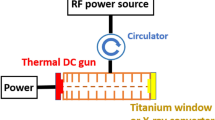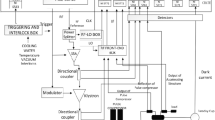Abstract
The development of a high-gradient accelerating structure is underway to construct a compact proton linear accelerator for cancer treatment. Extensive experiments and numerous studies are being conducted to develop compact linear accelerators for proton therapy. Optimization of the electromagnetic and mechanical design has been performed to simplify the manufacturing process and reduce costs. A novel high-gradient structure with a low relativistic proton velocity (β), v/c = 0.38, was designed, fabricated, and tested at high power. The first full-scale prototype was also successfully tested with high radio frequency (RF) power, a repetition rate of 50 Hz, and pulse length of 3 µs to reach a high-gradient of 46 MV/m using a 50 MW S-band klystron power supply obtained from the Shanghai Soft X-ray Free Electron Laser Facility. This is the first high-power test in China, which is in line with the expected experimental goal. This study presents preliminary high-power testing of S-band standing wave accelerating structures with 11 cells. This work aims to verify the feasibility of using a high-gradient RF accelerating structure in compact proton therapy facilities. The cold test of the prototype cavity was completed in advance. Details of the high-power RF test setup, the process of RF conditioning, and the high-power results are described.













Similar content being viewed by others
References
Particle Therapy Cooperative Group (PTCOG) Collaboration. http://www.ptcog.com.
P.J. Bryant, L. Badano, M. Benedikt et al., Proton-ion medical machine study (PIMMS). CERN (1999). https://doi.org/10.1007/bf03038873
Y.-H. Yang, M.-Z. Zhang, D.-M. Li, Simulation study of slow extraction for the Shanghai Advanced Proton Therapy facility. Nucl. Sci. Tech. 28, 120 (2017). https://doi.org/10.1007/s41365-017-0273-0
A.J. Lennox, Hospital-based proton linear accelerator for particle therapy and radioisotope production. Nucl. Instrum. Methods Phys. B 56–57, 1197–1200 (1991). https://doi.org/10.1016/0168-583X(91)95130-6
R. Cassetta, P. Piersimoni, M. Riboldi et al., Accuracy of low-dose proton CT image registration for pretreatment alignment verification in reference to planning proton CT. J. Appl. Clin. Med. Phys. 20(4), 83–90 (2019). https://doi.org/10.1002/acm2.12565
H.F. Ou, B. Zhang, S.J. Zhao, Gate/Geant4-based Monte Carlo simulation for calculation of dose distribution of 400 MeV/u carbon ion beam and fragments in water. Nucl. Sci. Tech. 27, 83 (2016). https://doi.org/10.1007/s41365-016-0097-3
J. Wang, X. Pei, R.F. Cao et al., A multiphase direct aperture optimization for inverse planning in radiotherapy. Nucl. Sci. Tech. 26, 010502 (2015). https://doi.org/10.13538/j.1001-8042/nst.26.010502
W.-C. Fang, X.-X. Huang, C.-P. Wang et al., Proton linac-based therapy facility for ultra-high dose rate (FLASH) treatment. Nucl. Sci. Tech. 32, 34 (2021). https://doi.org/10.1007/s41365-021-00872-4
C. Ronsivalle, A. Ampollini, G. Bazzano et al., The top implart linac: machine status and experimental activity. Proc. IPAC (2017). https://doi.org/10.18429/JACoW-IPAC2017-THPVA090
S. Benedetti, A. Grudiev, A. Latina, High gradient linac for proton therapy. Phys. Rev. Accel. Beams 20, 040101 (2017). https://doi.org/10.1103/PhysRevAccelBeams.20.040101
S. Pitman, R. Apsimon, G. Burt, et al., ProBE: Proton boosting extension for imaging and therapy, in Proceedings of 28th Linear Accelerator Conference, East Lansing, Michigan, USA 25–30 Sep 2016. https://doi.org/10.18429/JACoW-LINAC2016-MOPLR066.
C.-Q. Yu, Study on design of proton linacs (in Chinese). https://inis.iaea.org/collection/NCLCollectionStore/_Public/33/023/33023243.pdf
R.W. Hamm, K.R. Crandall, J.M. Potter, Preliminary design of a dedicated proton therapy linac, in Conference Record of the 1991 IEEE Particle Accelerator Conference, San Francisco, CA, USA, vol. 4, pp. 2583–2585 (1991).https://doi.org/10.1109/PAC.1991.165037
A. Degiovanni, U. Amaldi, D. Bergesio, et al., Design of a fast-cycling high-gradient rotating linac for proton-therapy, in Proceedings of International Particle Accelerator Conference - IPAC13, Shanghai, China, pp. 3642–3644 (2013). https://accelconf.web.cern.ch/IPAC2013/papers/thpwa008.pdf
S. Verdú-Andrés, U. Amaldi, A. Faus-Golfe, CABOTO, a high-gradient linac for hadron-therapy. J. Radiat. Res. 54(Suppl 1), i155–i161 (2013). https://doi.org/10.1093/jrr/rrt053
U. Amaldi, P. Berra, K. Crandall et al., LIBO-a linac-booster for proton therapy: Construction and test of a prototype. Nucl. Instrum. Meth. Phys. A 521, 512–529 (2004). https://doi.org/10.1016/j.nima.2003.07.062.
C. De. Martinis, D. Giove, U. Amaldi et al., Acceleration tests of a 3 GHz proton linear accelerator (LIBO) for hadron-therapy. Nucl. Instrum. Methods Phys. A 681, 10–15 (2012). https://doi.org/10.1016/j.nima.2012.04.017
A. Degiovanni, R. Bonomi, M. Garlasché et al., High gradient RF test results of S-band and C-band cavities for medical linear accelerators. Nucl. Instrum. Methods Phys. A 890, 1–7 (2018). https://doi.org/10.1016/j.nima.2018.01.079
C.H. Miao, M. Liu, C.X. Yin et al., Precise magnetic field control of the scanning magnets for the APTRON beam delivery system. Nucl. Sci. Tech. 28, 172 (2017). https://doi.org/10.1007/s41365-017-0324-6
J. Wu, H. Du, S. Xue et al., Gantry optimization of the Shanghai Advanced Proton Therapy facility. Nucl. Sci. Tech. 26, 040201 (2015). https://doi.org/10.13538/j.1001-8042/nst.26.040201
Y. Zhang, W.-C. Fang, X.-X. Huang et al., Design, fabrication, and cold test of an S-band high gradient accelerating structure for a compact proton therapy facility. Nucl. Sci. Tech. 32, 38 (2021). https://doi.org/10.1007/s41365-021-00869-z
G.-L. Wang, The research of control and measurement of the high-power testing platform based on high-gradient accelerating structures, Master’s Thesis. University of Chinese Academy of Sciences (Shanghai Institute of Applied Physics, Chinese Academy of Sciences), 2015.
J. W. Wang, G. A. Loew, Progress report on new RF breakdown studies in an S-band structure at SLAC, in Proceedings of the 1987 IEEE Particle Accelerator Conference: Accelerator Engineering and Technology. https://inis.iaea.org/search/searchsinglerecord.aspx?recordsFor=SingleRecord&RN=21007682
C.-G. Yao, Electron Linear Accelerator (Science Press, Beijing, 1986). (in Chinese)
S. Benedetti, A. Degiovanni, A. Grudiev et al., RF design of a novel S-band backward travelling wave linac for proton therapy, in Proceedings of LINAC2014, Geneva, Switzerland (2014). https://accelconf.web.cern.ch/LINAC2014/papers/thpp061.pdf
Z.-T. Zhao, D. Wang, Q. Gu et al., SXFEL A soft x-ray free electron laser in China. Synchrotron Radiation News 30, 29–33 (2017). https://doi.org/10.1080/08940886.2017.1386997.
X.-X. Huang, Study of the X-band high gradient accelerating structure and wakefield effects, Ph.D. Thesis. University of Chinese Academy of Sciences (Shanghai Institute of Applied Physics, Chinese Academy of Sciences), 2017. (in Chinese)
S. Tanaka, TOSHIBA Pulse Transformer Oil Tank Assembly. SPECIFICATION FOR VT-61181
T. Rao, D. H. Dowell, Chapter 2: Normal Conducting RF injectors.
H.-Y. Li, X.-M. Wan, W. Chen et al., Optimization of the S-band side-coupled cavities for proton acceleration. Nucl. Sci. Tech. 31, 23 (2020). https://doi.org/10.1007/s41365-020-0735-7
Author information
Authors and Affiliations
Contributions
All authors contributed to the study conception and design. Material preparation, data collection, and analysis were performed by Yu Zhang, Wen-Cheng Fang, Xiao-Xia Huang, Jian-Hao Tan, Shao-Peng Zhong, Cheng-Cheng Xiao, Jun-Qiang Zhang, Cheng Wang, Yu-Qing Yang, and Zhen-Tang Zhao. The first draft of the manuscript was written by Yu Zhang and all authors commented on previous versions of the manuscript. All authors read and approved the final manuscript.
Corresponding authors
Additional information
This work was supported by National Key R&D Program of China (No. 2018YFF0109203).
Rights and permissions
About this article
Cite this article
Zhang, Y., Fang, WC., Huang, XX. et al. Radio frequency conditioning of an S-band accelerating structure prototype for compact proton therapy facility. NUCL SCI TECH 32, 64 (2021). https://doi.org/10.1007/s41365-021-00891-1
Received:
Revised:
Accepted:
Published:
DOI: https://doi.org/10.1007/s41365-021-00891-1




